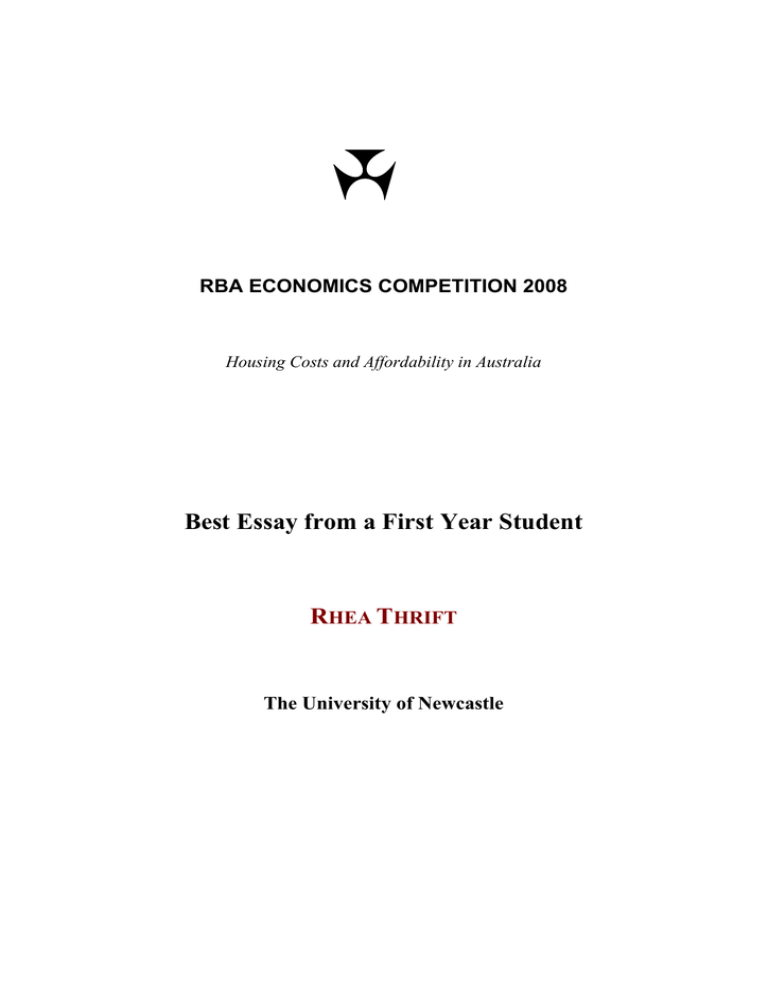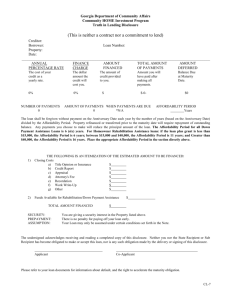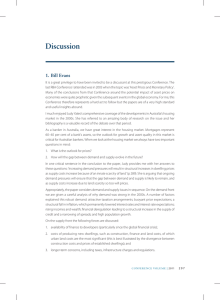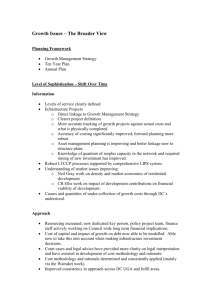Best Essay from a First Year Student R T
advertisement

RBA ECONOMICS COMPETITION 2008 Housing Costs and Affordability in Australia Best Essay from a First Year Student RHEA THRIFT The University of Newcastle Australia is in the midst of a housing affordability crisis. This essay seeks to analyse the extent to which this may be considered true by looking at the trends in house prices and affordability, as well as the causes of these trends and any possible policy action by government. Housing affordability can be split into different sections. People need somewhere to live, whether they buy their house or rent it. Therefore housing affordability also includes the affordability of rents as well as mortgages. Another split is between those who are looking to enter the housing market and those who already have a mortgage but may be suffering from mortgage stress. Trends The trend of high house prices has been going on for some time. In a recent speech Anthony Richards of the RBA noted that since 1972 house prices in Australia have risen faster than average household incomes, particularly in the late 1980s and during the housing boom that started in the late 1990s.1 Housing affordability is usually defined as spending up to 30% a household’s income on mortgage repayments or rent.2 Over the past two decades house prices have risen, matched by a decrease in housing affordability. For example, between 1990 and 2007 the median house price in Sydney rose from $185000 to $530000 including a doubling of prices in the housing boom between 1997 and 2003.3 Between 1996 and 2006 average house prices rose by 100% with mortgages rising by 50%.4 In 1996 Australia’s total housing debt was $125 billion, in 2006 it was over $350 billion.5 This means that a household now needs 34.8% of their income to meet an average loan repayment, well above the 30% limit. Housing affordability has only been this difficult at one other point in Australia’s history – between June 1989 and June 1990, when interest rates peaked at 17.5%.6 Repossessions are also on the rise. In 2007 in New South Wales nearly 5500 households had their homes repossessed. To put that in perspective, it is a 60% increase on the number of repossessions that occurred during the last recession.7 1 Anthony Richards, ‘Some Observations on the Cost of Housing in Australia’, speech delivered at the Economic and Social Outlook Conference, Melbourne, 27 March 2008. 2 Gerard Watkins, ‘The Great Australian Housing Nightmare’ (2007) 7(4) AQ: Journal of Contemporary Analysis 14; note that this definition only applies to households in the bottom 40% of the income distribution (Anthony Richards, n 1 above). 3 Roslyn Alderton, ‘Solving the Housing Dilemma’ (2007) 58(8) Real Estate Institute of New South Wales Journal 7. 4 Watkins, above n 1. 5 Jago Dodson and Neil Sipe, ‘Cracks in the Veneer’ (2007) 15 Griffith Review 67. 6 Alderton, above n 2. 7 ABC Television, ‘Debtland’, Four Corners, 31 March 2008. Causes The main cause of rising house prices in Australia has been an increase in demand not matched by an increase in supply, illustrated in general terms in Graph 1 below. Graph 1 General Model of Housing Affordability Trends Price S D3 D2 D1 Quantity of Supply, Demand The increases in demand have come from many sources such as population growth,8 low interest rates after the 1990-91 recession and a generally booming economy with rising wages.9 Cuts to capital gains tax in 1999 have also made negative gearing more attractive.10 The effect of this has been increased investment in property by those looking to minimise tax, squeezing owner-occupiers and first home buyers out of the market.11 Households are also getting smaller, while houses are getting bigger. Between 1994-5 and 2003-4 the average number of people per household fell from 2.7 to 2.5, while at the same time the amount of bedrooms per house on average has increased from 2.9 to 3.12 So while Australia’s total population grew by 12% in the decade to 2001, the total number of private occupied 8 For example, the NSW government predicts Sydney’s population will grow by 9.6% by 2016 (REINSW ‘Housing Affordability’ (2007) 58(1) Real Estate Institute of New South Wales Journal 4). 9 Ben Eltham, ‘Fixing Politics: the Housing Affordability Crisis’, Crikey (Internet), 26 June 2008, Alderton, above n 2. 10 Watkins, above n 1. 11 Kim Wyatt, Jarrod McDonald and Mohan Nandha, ‘Negative Gearing and Housing Affordability for First Home Buyers’ (2005) 8(1) Journal of Australian Taxation 150. 12 Susan Linacre, ‘Larger Dwellings, Smaller Households’ (2007) ABS article from Australian Social Trends 2007 <http://www.abs.gov.au/ausstats/abs@.nsf/latestproducts/8DD7826E7F7235D8CA25732C0020820B?opendocument> at 30 dwellings increased by 21% over the same period.13 This suburban sprawl means that not only is the population growing, but so is the amount of housing required per person. There is also suggestion that government subsidies to buy houses, such as the first homebuyers grant, only translates into higher prices without actually affecting housing affordability.14 Graph 1 depicts a relatively inelastic supply curve. This is due to the fact that housing affordability is largely a supply issue. As housing approvals are subject to development regulations etc supply is not very responsive to demand. Over the ten years to 2001 the increase in new dwellings was modest, despite rising demand levels. In New South Wales, for example, there has even been a trend of falling approvals for new houses since 2002, illustrated in Graph 2.15 Graph 2 Dwelling Units Approved in NSW The lending practices undertaken by banks have also affected house prices. Banks have been more willing to lend above historical standards.16 When giving loans, banks have calculated what someone needs to live on in order to calculate a loan amount. In recent years they have been using a poverty index to do this, inflating how much they could reasonably lend to people.17 Banks apply a protective margin for interest rate rises, that is how many interest rate rises someone can absorb and still be able to meet their loan repayments and their basic needs. This is called a serviceability buffer. The ABC’s Four Corners recently quizzed financial institutions including the Commonwealth Bank, Bendigo Bank June 2008. 13 ABS, ‘Housing Stock: Supply of Housing’ (2005) ABS article from Australian Social Trends 2005 <http://www.abs.gov.au/ausstats/abs@.NSF/94713ad445ff1425ca25682000192af2/9d4e11e2d52cace4ca25703b0080cccb! OpenDocument> at 5 August 2007. 14 Richards, above n 1 and Watkins, above n 1. 15 ABS, Dwelling Units Approved (2008) <http://www.abs.gov.au/AUSSTATS/abs@.nsf/Latestproducts/8731.0Main%20Features5Jun%202008?opendocument&tab name=Summary&prodno=8731.0&issue=Jun%202008&num=&view=> at 31 July 2008. 16 RBA and APRA, ‘Joint RBA-APRA Submissions to the Inquiry into Home Lending Practices and Processes’ (2007). 17 Brian Johnston, banking analyst from JP Morgan interviewed in ABC Television, above n 7. and Suncorp Metway on their serviceability buffer. They ranged from 3% to a tiny 0.6%.18 By comparison the cash rate has gone up by 2.75 percentage points since May 2002.19 The advent of interest only loans has encouraged and enabled negative gearing practices. A report released in April by Fujitsu Consulting, entitled Anatomy of Australian Mortgage Stress, found that the leading cause of mortgage stress for households is interest rate rises.20 As interest rates have risen since May 200221 the cost of servicing debt has increased substantially, increasing mortgage stress on households. Rents have risen slower than mortgage repayments, and therefore the price signals are pushing people out of the house market and into the rental market.22 This means that rents, too, are on the rise. Policy Options The two strongest arguments to support government intervention in the housing market are that young people are being squeezed out of the housing market, and that many people when they retire live off the equity in their homes, as well as government pensions or superannuation. These are quite compelling reasons, that strongly support government action with regards to housing affordability. At a macroeconomic level, the government can tighten fiscal policy thereby taking pressure off the RBA to lift interest rates. This means that households will not have to pay more for other items in the household budget, meaning they can absorb higher house prices. The cost of this is unemployment, making it a highly inefficient policy. It is also a highly inequitable policy as it does nothing to address the issue of first home buyers and other low income buyers being squeezed out of the market by high house prices. It has been estimated that the tax breaks given to investors by capital gains tax arrangements, land tax exemption and negative gearing is $50 billion per year.23 An end to these arrangements would control demand from investors and significantly reduce house prices. This would also be an efficient option, as the market would not be distorted by the government giving tax breaks to only one group of buyers. As 18 ABC Television, above n 7. Cash Rate Target (ongoing) Reserve Bank of Australia <http://www.rba.gov.au/statistics/cashrate_target.html> at 16 July 2008 20 Lucinda Schmidt, ‘Battle on the Home Front’, Sunday Life: the Sun –Herald Magazine (Sydney) 20 July 2008. 21 Eltham, above n 9 notes that over 800 000 are in housing stress. 22 Glenn Dyer, ‘Rental Pain Shows No Sign of Easing’, Crikey (Internet), 2 May 2008. 23 Senate Committee on Housing Affordability reported in Eltham, above n 9. 19 such, direct subsidies such as the first home buyers grant should also be ended, as they do not make housing more affordable. They are a poorly targeted policy as they are not means tested and they translate directly into higher prices, which again is a distortion. The First Home Saver Accounts announced by the Rudd government in the 2008-09 budget,24 however, are a better policy option. This is because it seeks to prevent people borrowing the full cost of their home, so mortgages will be lower, it encourages higher national saving and it is not providing extra money that will just create higher prices. On the supply side, releasing more land for development would increase the supply of housing and bring prices down. However, there are some problems with this. The first is that much of the land that could be released is on the outskirts of cities in areas such as western Sydney. With house prices already falling in these areas,25 increasing supply in this way will just lead to even lower house prices, while prices closer to the city will remain high. This is a problem because many people who bought homes in this area during the housing boom now owe more on their mortgage than what their house is worth. This same group of people are the ones who are most affected by rising cost of living pressures, such as fuel prices, making things such as commuting to work harder.26 A different solution is higher density housing in inner city areas, combined with better urban planning. This would put living in popular, inner-city areas within reach of more people. Greater scrutiny of lenders, especially non-bank financial institutions could prevent mortgages getting out of control. However this would be an impediment to competition in the market. These regulatory measures could lead to less money in the economy (due to the effect of the money multiplier) and therefore prices would rise more slowly. The implementation of efficient and cheap public transport systems is an option, so that living in for example the western areas of Sydney becomes possible for inner city workers. This takes pressure off other cost of living pressures such as rising fuel prices. If public transport was extended to these areas, it is possible that more people would choose to live in areas with lower house prices. This would even out demand levels across all areas of cities. Rental affordability is becoming particularly important as people turned away from the housing market 24 Australian Government, Budget 2008-09 <www.budget.gov.au> at 17 July 2008. Kelvin Bissett and Justin Vallejo, Sydney House Prices in Landslide (2008) news.com.au <http://www.news.com.au/business/money/story/0,25479,23309209-5013951,00.html> at 17 July 2008. 26 Eltham, above n 9. 25 are turning to rental properties, increasing demand and therefore rents. Policy options to address rental affordability are a move away from ‘mum and dad’ landlords and longer term leases. Increasing private investment in housing could generate economies of scale, bringing down costs and therefore rents. However this is best achieved by negative gearing incentives for investors, which in turn affects house prices. Australia also has levels of public housing well below international standards. For example, there are now 30 000 fewer public housing dwellings in Australia then there were a decade ago. The average time spent on the waiting list for someone under 55 in Melbourne is thirteen years.27 Governments could increase the amount of public housing available, to give low income earners somewhere affordable to live. It is a sad fact that housing affordability will always affect those at the bottom of society first and hardest. This is a policy solution that will address the inherent inequality of housing affordability problems. Randwick council has already supplied land and a grant to build affordable public housing for key workers on low incomes, such as teachers.28 Housing affordability has become a bigger problem in Australia over the last two decades. There is a growing fear within the community that young people are being squeezed out of the housing market and may never own their own home. However rents are also on the rise, meaning that housing affordability has the potential to affect a wide range of the community. The main reasons for rising house prices and decreasing affordability are demand outstripping supply, banks lending practices and rising interest rates. While it may not be a good idea for the government to intervene directly in the housing market through policies such as direct subsidies, there are actions they can take to manage the problem, such regulatory measures for financial institutions, leveling the field by removing tax breaks such as negative gearing, public transport and providing financial counseling. There is also a place for government to increase the supply of low cost housing especially through public housing initiatives. It is in these ways that the issue of housing affordability may be tackled. 27 28 Watkins, above n 1. Schmidt, above n17.






